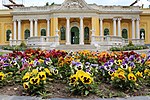1956 Budapest earthquake
1956 disasters in Hungary1956 earthquakes1956 in HungaryEarthquakes in EuropeGeology of Hungary ... and 3 more
History of BudapestJanuary 1956 events in EuropeNatural disasters in Hungary
On 06:46:13 CET on 12 January 1956, a rather unusual earthquake measuring 5.8 on the moment magnitude scale struck just southeast of Budapest under Dunaharaszti at a depth of 15 km. The earthquake had a maximum European macroseismic intensity of VIII (Heavily damaging). The earthquake was felt throughout Hungary other than the eastern and western edges of the country. The event was preceded by 31 other weaker events. There was widespread damage to homes and other structures; 2 died and 48 were injured. The earthquake was one of the strongest to ever strike Hungary and the worst during the 20th century.
Excerpt from the Wikipedia article 1956 Budapest earthquake (License: CC BY-SA 3.0, Authors).1956 Budapest earthquake
Merzse tanösvény, Budapest Rákoshegy
Geographical coordinates (GPS) Address Website Nearby Places Show on map
Geographical coordinates (GPS)
| Latitude | Longitude |
|---|---|
| N 47.44 ° | E 19.28 ° |
Address
(GCXVII) Merzse-mocsár
Merzse tanösvény
1174 Budapest, Rákoshegy
Hungary
Open on Google Maps









